The Oldest Living Things in the World
Air Date: Week of May 30, 2014
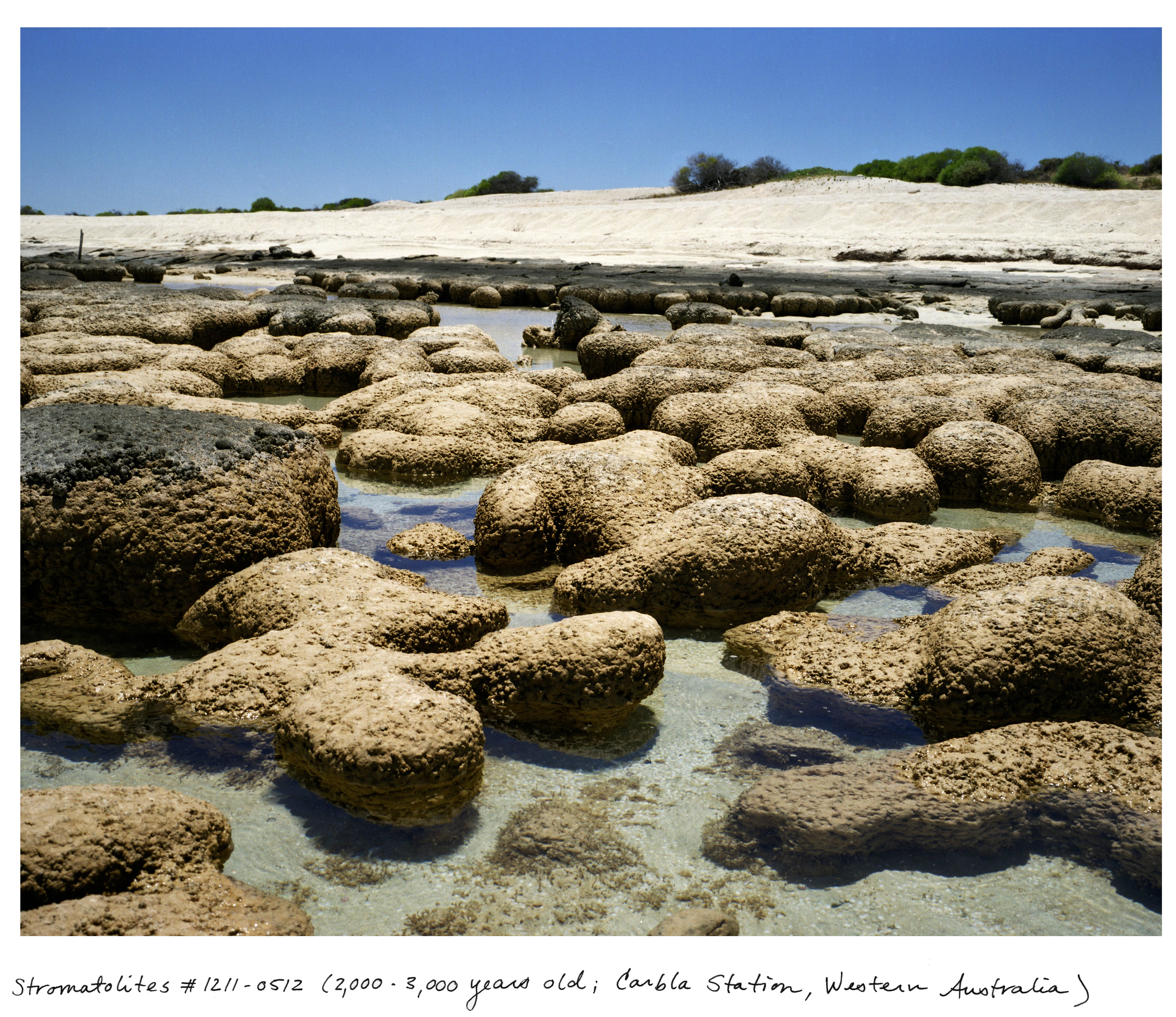
Stromatolites #1211-0512 (2,000 - 3,000 years old; Carbla Station, Western Australia) Straddling the biologic and the geologic, stromatolites are organisms that are tied to the oxygenation of the planet 3.5 billion years ago, and the beginnings of all life on Earth. (Photo: ©Rachel Sussman The Oldest Living Things in the World)
Brooklyn-based contemporary artist Rachel Sussman speaks with host Steve Curwood about her journey around the globe photographing ancient organisms for her book The Oldest Living Things in the World
Transcript
CURWOOD: The oldest person ever certified died in France in 1997 at age 122. The current oldest lives in Japan, she's 116. The maximum human lifespan seems to be around 120 years while the mayfly, an aquatic insect, emerges, breeds and dies within hours. But there are also organisms that can live for thousands of years, and these are the subject of a striking book of photographs by Rachel Sussman. A contemporary artist and photographer based in Brooklyn, Rachel Sussman spent the last 10 years traveling the globe, capturing images of the extremely old organisms. She joins us today to discuss “The Oldest Living Things in the World.” Welcome to the program.
SUSSMAN: Thank you so much.
CURWOOD: So what inspired you to find and photograph the world’s oldest living things?
SUSSMAN: It’s really a combination of things. I've been photographing since I was little and always interested in the relationship between humanity and nature, but I was really interested in creating a project that dealt with the sciences as well as some philosophical thinking, this look at deep time and long-term thinking, all with a strong environmental underpinning.
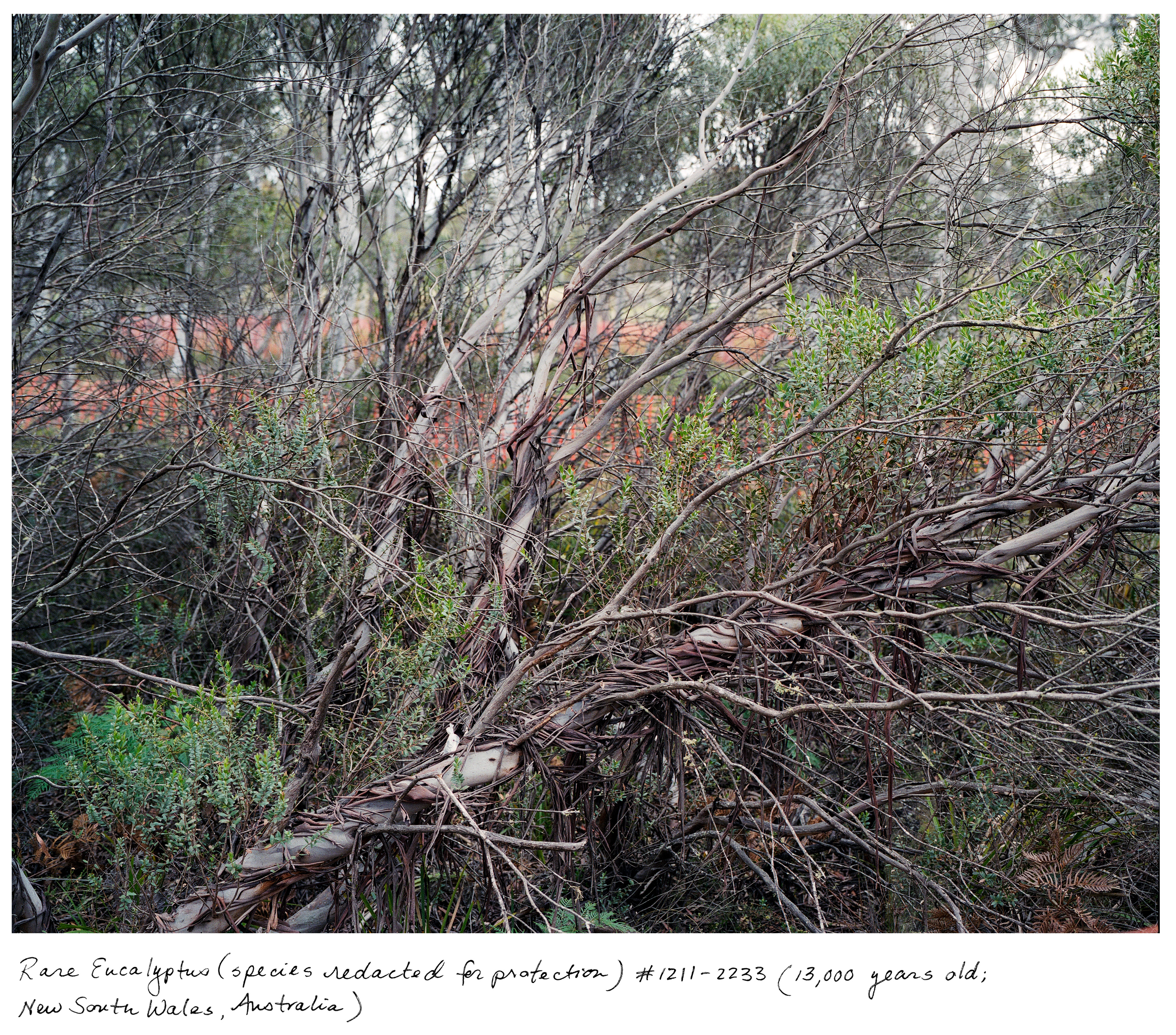
Rare Eucalyptus (species redacted for protection) #1211-2233 (13,000 years old; New South Wales, Australia)
This critically endangered eucalyptus is around 13,000 years old, and one of fewer than five individuals of its kind left on the planet. The species name might hint to heavily at its location, so it has been redacted. (Photo: ©Rachel Sussman The Oldest Living Things in the World)
CURWOOD: So the book is called “The Oldest Living Things in the World”. What kind of things are we talking about?
SUSSMAN: For the most part they are what you'd expect, a lot of plants, a lot of trees but there's also some things you might not expect, for instance, bacteria, fungus, as well as some animals.
CURWOOD: Going through your book, I noticed that you said you actually never found a true longevity expert, so how did you find these different organisms?
SUSSMAN: So very early on I had looked for a scientist that would collaborate with me and be my partner through the project and they very quickly recused themselves, and said, “Oh, no, we’re not expert enough for that because there is no area in the sciences that deals with longevity across species.” So what happened was I ended up working with individual experts.
CURWOOD: How did you determine the age of these organisms? Typically I imagine you used, you looked at different isotopes of carbon.
SUSSMAN: Certainly; well so this is actually a reason why the whole concept of creating an area of study about longevity is quite complicated, and that is, all these different types of organisms are dated in different ways. So the best-case scenario is when you have published scientific research papers that share an exact vetted age of an organism. In some cases there are educated guesses which are ranges and in some cases there's just some hearsay.
CURWOOD: There's two kinds of old in here: one kind refers to a single organism, another refers to things that are cloned. Can you explain the differences for us please?
SUSSMAN: Certainly, so there are these two types generally speaking that we're dealing with, and one is unitary organisms, and that’s something that we’re probably all most familiar with. A single tree is generally a unitary organism. So the more complex organisms are sometimes referred to as clonal or employing vegetative growth or rhizomatic and what that means is that they're self- propagating without the introduction of new outside genetic material, so there's no sexual reproduction happening.
CURWOOD: Most of your book is about plants but the very oldest aren’t. Can you tell me about those?
SUSSMAN: The very oldest known thing on Earth, and I say the oldest known because it doesn't mean that it is absolutely the oldest, is something referred to as the Siberia actinobacteria, and it does in fact live in Siberia and it's between 400,000 and 600,000 years old. This bacteria was discovered by a team of planetary biologists looking for clues to life on other planets by visiting one of the harshest areas on Earth. So what they did was they took a core sample deep into the permafrost and were quite surprised to discover this bacteria because what's special about it is that it's doing DNA repair below freezing so that differentiates it from bacteria found in the Arctic and Antarctic that's been dormant.
CURWOOD: I was intrigued by the photograph you have of these lichens on Greenland. How did you go about finding them?
SUSSMAN: So the researcher who was working with me with the Siberian actinobacteria said, “Oh, you're interested in things over 2,000 years old. I'm going to Greenland next summer, and there are lichens over 2,000 years old” and asked if I wanted to join them. So the lichens are known as the map lichens, Rhizocarpon geographicum. In Greenland they grow one centimeter every hundred years, and that's one of my favorite statistics in the whole project, and that really puts a human lifespan into perspective. I mean, what if you spent your entire life just growing one centimeter?
CURWOOD: There are pictures of the seagrass in Spain that you say is some hundred thousand years old…how did you get those pictures?

Posidonia Oceania Sea Grass #0910-0753 (100,000 years old, Balearic Islands, Spain)
At 100,000 years old, the Posidonia sea grass meadow was first taking root at the same time some of our earliest ancestors were creating the first known “art studio” in South Africa. It lives in the UNESCO-protected waterway between the islands of Ibiza and Formentera. (Photo: ©Rachel Sussman The Oldest Living Things in the World)
SUSSMAN: [LAUGHS] I learned to scuba dive. So that was one of my fears I actually had to face. Scuba diving was not something that ever appealed to me so it was quite fortunate I was able to join them in the field, so I ended up going out with the researchers as they were very carefully counting these plotted areas, counting the number of shoots to look at the health of the meadow.
CURWOOD: Most of these old things are pretty laid back, but you found one that you call predatory. What is that?
SUSSMAN: Yes, I mean, not that anybody should run away in alarm. Armillaria fungus is predatory but it only attacks certain species of trees, so this is also known as the humongous fungus which some people might have heard about living in eastern Oregon. It happens to be the largest organism in the world as well, but it lives almost entirely underground so it's a little bit tricky to photograph as you can imagine but what it does is it invades certain species of trees and essentially strangles them to death. But it's also pretty clever. It doesn't actually do this until the tree has met reproductive age so it ensures that'll be progeny for it to kill later.
CURWOOD: And how old is this humongous fungus?
SUSSMAN: The humongous fungus is 2,400 years old.
CURWOOD: A mere babe compared to the bacteria that goes back more than a half a million.
SUSSMAN: Certainly and it's an interesting thing where you have a number of the younger organisms in my project tend to be the larger ones, and the ones that are the oldest tend to be growing the most slowly.
CURWOOD: So what’s your most memorable event and thing and why?
SUSSMAN: So one of my absolute favorite experiences was going to visit a plant called the llareta, in the Atacama desert in Chile. And this is in very high elevations around 15,000 feet and, you know, you’re driving through the Atacama desert, parts of this are absolute desert where there's no recorded rainfall in all of human history and so as you go further up into the mountains you start to get a little bit of green and finally I was with a researcher who took me to this place whether the llaretas were growing, and the llareta looks like moss covering rocks but it's actually a shrub and it's incredibly dense. It also happens to be related to parsley which I found amusing, but it's something that looks completely alien and you're already in this really alien looking landscape because it's so arid. But the llareta is made of thousands of these branches so densely packed together you could actually climb on top of them and at the end of each branch this little cluster of leaves and they also flower there, it’s a flowering shrub, and also became the poster child of the project because it’s something that most people aren't familiar with. I certainly was never familiar with them before beginning this project.
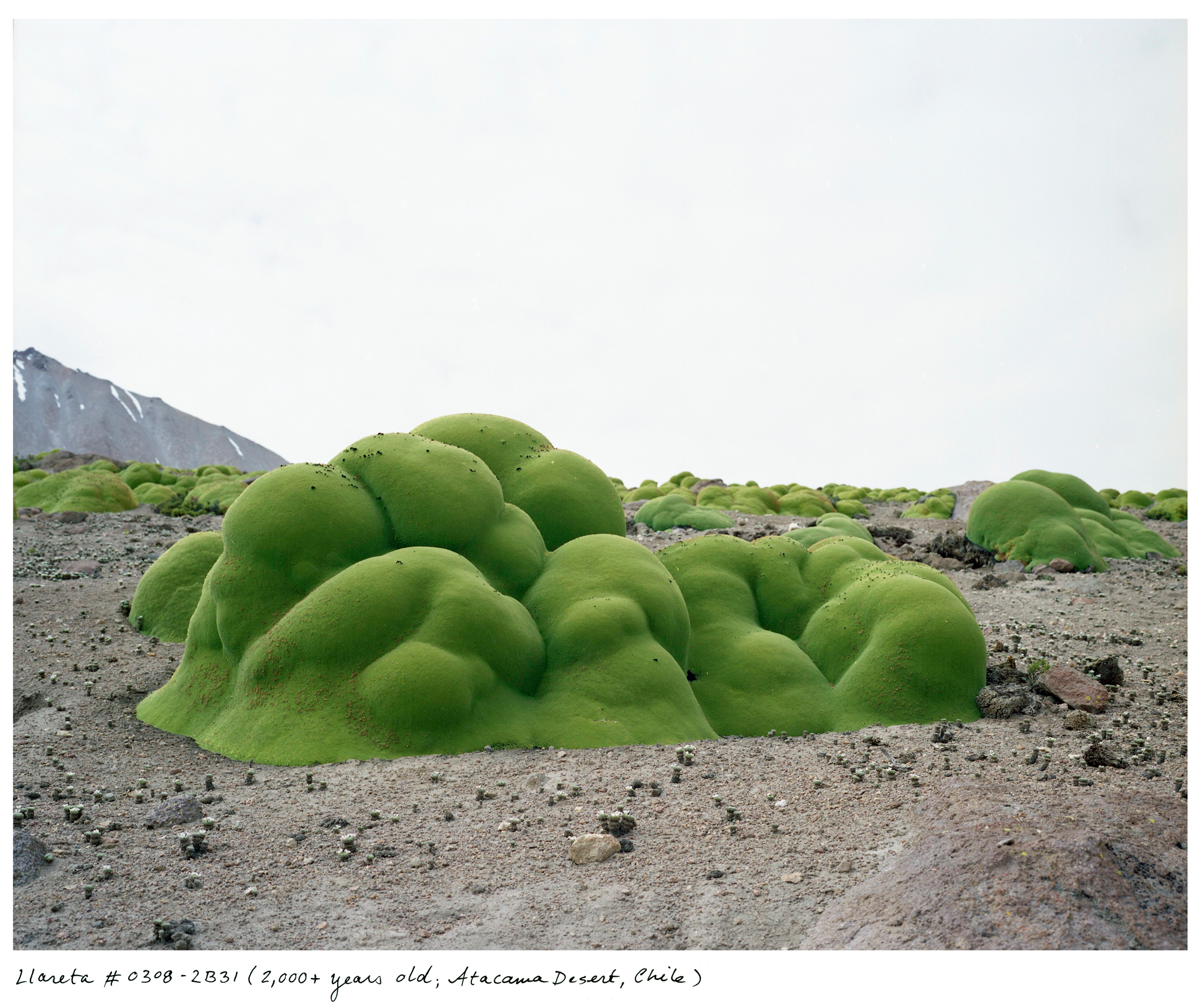
La Llareta #0308-2B31 (2,000+ years old; Atacama Desert, Chile)
What looks like moss covering rocks is actually a very dense, flowering shrub that happens to be a relative of parsley, living in the extremely high elevations of the Atacama Desert. (Photo: ©Rachel Sussman The Oldest Living Things in the World)
CURWOOD: How old is the llareta?
SUSSMAN: There are number of different llaretas that I photographed even, so the one primary image is probably around 3,000 years old, and then there's one that looks even bigger but it's actually two llaretas next to each other, so the estimate on that is around 2,000 years old.
CURWOOD: You went back to some of the sites. What was it like going back to see those organisms again and take more pictures and how did it change your experience of it?
SUSSMAN: Yeah, several of the organisms I did revisit. The most profound I would say was my experience at the Senator tree, and it was 3,500 years old. It’s a bald Cypress tree in Florida. I first visited the senator tree in 2007 and I had made some photographs that I just wasn't crazy about. And I thought, “you know what, I just got to come back. It'll be really easy.” Lo and behold, five years later, the tree was dead. It was killed by some kids who snuck into the park at night and the tree was hollow in the center and they thought it would be fun to duck in there and take some drugs and they burnt it down, but it really reminded me…it jolted me out of this sort of complacency or this feeling of like, “oh, these things are going to be around for so long I am making at sort of time capsule of this moment but they’ll be here for a while,” and in some cases that just isn't true.
CURWOOD: But what went away?
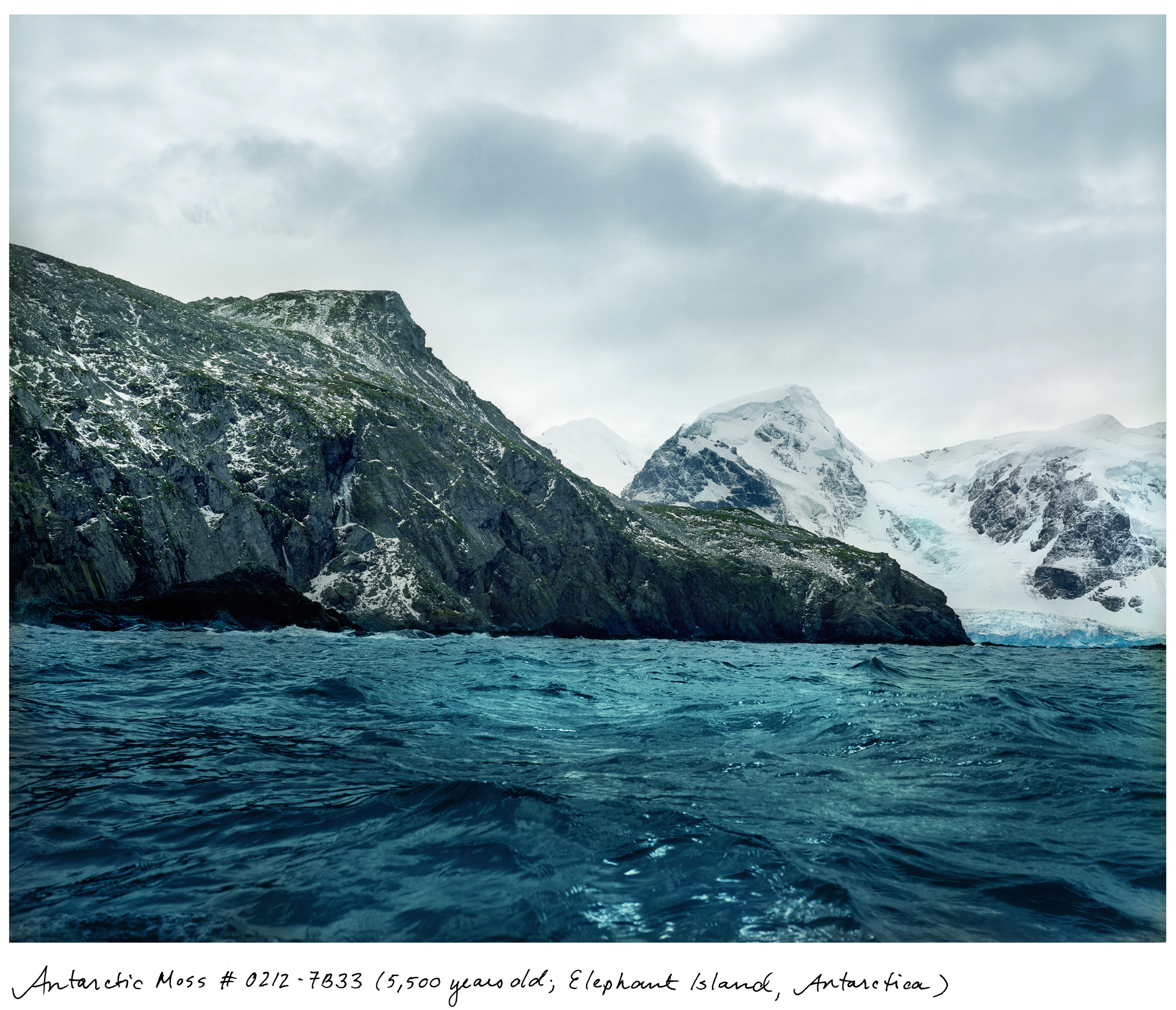
Antarctic Moss #0212-7B33 (5,500 years old; Elephant Island, Antarctica)
This 5,500-year-old moss bank lives right around the corner from where the Shackleton Expedition was marooned 100 years ago on Elephant Island, Antarctica. It was a victory simply being able to locate it. These days it's easier to get to Antarctica from space.
(Photo: ©Rachel Sussman The Oldest Living Things in the World)
SUSSMAN: So two of them we lost and they were both at human hands. So one was the Senator tree, and the other one was something known as a underground forest in Pretoria, South Africa. Now, thankfully it's not the only one of its kind but this was a 13,000-year-old clonal shrub living outside the botanical garden and it got bulldozed right over in order to accommodate a new roadway.
CURWOOD: Tell me, how do these oldest living things behave as "the record in celebration of the past, a call to action in the present, and a barometer of our future,” and I'm quoting you.
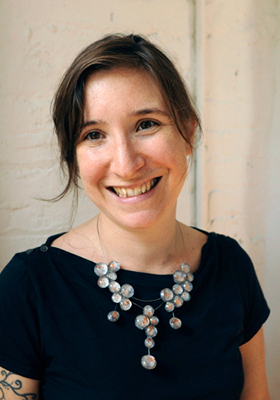
Rachel Sussman author of The Oldest Living Things in the World (photo: Laura Holder)
SUSSMAN: Certainly, yes, I mean, I really look at these organisms as something that belong to us all and transcend the things that divide us. They’re symbolic of both a deeper time period and history that is something collective to us living on earth and likewise something that we're responsible for and I find them both to be hopeful in terms of symbolically…their longevity is certainly something that is both surprising and admirable but it's also hanging in the balance. So climate change is a real and present danger and it's something that is in the hands of all of us. So I hope that these organisms will help to serve as something that connects us all and is transcendent of the small things that get in the way on the daily basis.
CURWOOD: Rachel Sussman's new book is called “The Oldest Living Things in the World.” Thank you so much for taking the time with us today.
SUSSMAN: Thank you. It’s my pleasure.
Links
Follow Rachel Sussman’s work on her website
For more information on The Oldest Living Things in the World, visit the University of Chicago Press
Living on Earth wants to hear from you!
Living on Earth
62 Calef Highway, Suite 212
Lee, NH 03861
Telephone: 617-287-4121
E-mail: comments@loe.org
Newsletter [Click here]
Donate to Living on Earth!
Living on Earth is an independent media program and relies entirely on contributions from listeners and institutions supporting public service. Please donate now to preserve an independent environmental voice.
NewsletterLiving on Earth offers a weekly delivery of the show's rundown to your mailbox. Sign up for our newsletter today!
 Sailors For The Sea: Be the change you want to sea.
Sailors For The Sea: Be the change you want to sea.
 The Grantham Foundation for the Protection of the Environment: Committed to protecting and improving the health of the global environment.
The Grantham Foundation for the Protection of the Environment: Committed to protecting and improving the health of the global environment.
 Contribute to Living on Earth and receive, as our gift to you, an archival print of one of Mark Seth Lender's extraordinary wildlife photographs. Follow the link to see Mark's current collection of photographs.
Contribute to Living on Earth and receive, as our gift to you, an archival print of one of Mark Seth Lender's extraordinary wildlife photographs. Follow the link to see Mark's current collection of photographs.
 Buy a signed copy of Mark Seth Lender's book Smeagull the Seagull & support Living on Earth
Buy a signed copy of Mark Seth Lender's book Smeagull the Seagull & support Living on Earth

